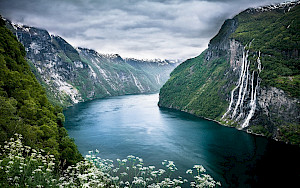 Norway truly is a country powered by nature and it does not do nature on a small scale. It is a land of earth-shattering glaciers, mountains and fjords of epic proportions, and countless coastal islands scarcely touched by civilization. Its national culture is one of an anti-urban bias that idealizes the natural environment and rural life.
Norway truly is a country powered by nature and it does not do nature on a small scale. It is a land of earth-shattering glaciers, mountains and fjords of epic proportions, and countless coastal islands scarcely touched by civilization. Its national culture is one of an anti-urban bias that idealizes the natural environment and rural life.
Norway’s most famous ancestors…
The Vikings are a big part of Norway's history. When you think of Vikings, it's not poetry, woodcarving and storytelling that spring to mind, but colorful images of horned helmets, long ships, and men drinking out of skulls. But they were so much more.
The Viking Age was from 800 AD to 1050 AD, and during this time the Vikings raided various places including Ireland, France, England and Scotland. They are commonly known for being ruthless fighters and it’s true. The Vikings were pirates who spread terror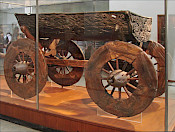 along Europe's coasts. But their reputation is not entirely fair. They were not just ruthless warriors, but also skilled traders and craftsmen in metal and wood producing beautiful jewelry, tools, and artifacts that have survived to this day. The Vikings were also some of Europe's best storytellers and their tales and poems of Norse sagas continue to fascinate modern audiences. It’s a heritage that is warmly revered and celebrated still today.
along Europe's coasts. But their reputation is not entirely fair. They were not just ruthless warriors, but also skilled traders and craftsmen in metal and wood producing beautiful jewelry, tools, and artifacts that have survived to this day. The Vikings were also some of Europe's best storytellers and their tales and poems of Norse sagas continue to fascinate modern audiences. It’s a heritage that is warmly revered and celebrated still today.
Natural beauty as far as the eye can see…
Norway is a nature lovers dream come to life. Often cited as one of the world’s most beautiful rail journeys, the Oslo-Bergen rail line is an opportunity to sample some of Norway’s best scenery. Then, venture on to sail the unspoiled islands of Solund, before gazing in wonder at the awesome views of Aurlandsfjord and Hardangerfjord.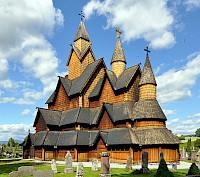
When you travel through Norway, you may have a chance to see some of this country's stave churches, which are an integral piece of Norway's architectural heritage. These churches were built during the Middle Ages and are made of wood, rather than the traditional stone churches that were being built throughout other parts of Europe. The woodwork was, and still is, extremely intricate and richly decorated with animal motifs such as doves, dragons, centaurs and elk. The oldest known stave church in Norway is the Urnes Stave Church, near Sognefjord, built in 1150.
There is not a more uplifting natural phenomena than the aurora borealis, or northern lights. Visible throughout the long night of the Arctic winters, they dance across the sky in green or white curtains of light, taking on forms that seem to spring from a child’s vivid imagination. While there’s no guarantee that the northern lights will appear, if you are lucky enough to see them it’s an experience that will live with you forever.
The high country of central Norway ranks among Europe’s premier summer destinations. Although there are numerous national parks, it’s Jotunheimen National Park, whose name translates as ‘Home of the Giants’, that rises above all others. With 60 glaciers and 275 summits over 6,500 feet, this park stands on its own. Jotunheimen is exceptionally beautiful and home to iconic trails such as Besseggen, Hurrungane and those in the shadow of Galdhøpiggen, Norway’s highest peak.
Oslo is reinventing itself. This is a city aiming to become nothing less than a world renowned center of culture. It’s already bursting at the seams with museums and top-notch art galleries. A must see is the Vikings Museum in Oslo. The museum houses the world's best preserved Viking ships and finds from Viking tombs around the Oslo Fjord. The exhibits show discoveries from the Gokstad, Oseberg and Tune ships, plus other small boats, beautiful carts, tools, textiles and household utensils crafted by the Norse seafarers. The Natural History Museum is another way to get your fill of Norwegian history containing the country’s largest collection of natural objects. While there, stroll through the impressive Botanical Garden and the Zoological Museum.
The Holmenkollen Ski Museum and Ski Jump Tower in Oslo is another popular attraction. It was founded in 1923 and is the world's oldest ski museum. The museum contains 4,000 years of skiing history and rock carvings from the Stone Age, showing skiers and skis from the Viking Age.
Bergen is Norway’s second largest city, but one with a quaint, small town charm and atmosphere. While there, visit Bryggen, "The Hanseatic Wharf" which today is home to many of the city’s restaurants, pubs, craft shops and historical museums.
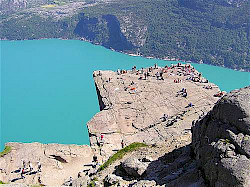 As lookouts go, Pulpit Rock is one of Norway’s signature images and most eye-catching areas. It’s the sort of place where you’ll barely be able to look as travelers dangle far more than seems advisable over the edge. Speaking of eye-catching areas, few visitors forget their first sighting of the Lofoten Islands, laid out in summer greens and yellows, their razor-sharp peaks poking dark against a clear, cobalt sky.
As lookouts go, Pulpit Rock is one of Norway’s signature images and most eye-catching areas. It’s the sort of place where you’ll barely be able to look as travelers dangle far more than seems advisable over the edge. Speaking of eye-catching areas, few visitors forget their first sighting of the Lofoten Islands, laid out in summer greens and yellows, their razor-sharp peaks poking dark against a clear, cobalt sky.
There’s no finer way to explore the Arctic wilderness than on a sled pulled by a team of huskies. You might find yourself enjoying being blissfully free from engine noise and the din of modern life, accompanied by a soundtrack of the scrape of the sled across the snow, these excursions will take you out into the trackless world of Norway’s far north and allows you to immerse yourself in the eerily beautiful light of an Arctic winter.
No matter where you wander, you will be pleased.
Knowing Norwegian...
Norwegian is a Germanic language, so learning a decent form of Norwegian shouldn't be too hard if you already speak English, German or Dutch. Norwegian grammar is similar to English and relatively easy compared to German. It's also closely related to Danish and Swedish, so most speakers of the three languages can understand each other without much difficulty.
Although modern Norwegian is relatively easy to understand and practice at a superficial level, learning Norwegian a hundred percent fluently is exceptionally difficult. There are several reasons to this. The first thing worth mentioning is that there is a wide range of dialects of Norwegian that could differ significantly to the standard written form.
Also, there are two official variations of written Norwegian: Bokmål and Nynorsk. The differences are small, but important to a lot of Norwegians. Bokmål, previously referred to as Riksmål, is by far the most common and evolved from Danish. Nynorsk is a reconstructed standard written form. However, speaking the different dialects is accepted in all regions. Also, English is widely spoken in the cities, but you may find it's less so in the rural areas and towns.
Here are some common phrases you might want to learn and as with learning any new language, it’s always best to hear it spoken. Here is a site that can get you started in hearing these phrases spoken, http://www.linguanaut.com/english_norwegian.htm.
Hi -- Hei
Good morning -- God morgon
Good evening -- God kveld
How are you? -- Korleis har du det?
Thank you very much -- Tusen takk
You're welcome -- Ver så god
Good night -- God natt
Excuse me -- Unnskyld
Do you speak English? -- Snakkar du engelsk?
My name is -- Eg heiter
What is your name? -- Hva heterdu?
I'm sorry -- Jeg er lei meg
I don't understand you -- Jeg forstår deg ikke
Hearty meals that satisy...
A favorite of being in any new location is trying the local food. Norwegian cuisine in its traditional form is based largely on what is readily available in Norway and its mountains, wilderness and coasts, with a strong focus on game and fish. Modern Norwegian cuisine, although still strongly influenced by its traditional background, now bears the results of globalization with pasta, pizza, tacos and the like becoming more common.
There are a few Norwegian delicacies you should try. Something you will find a lot of is Røkt Laks or Smoked Salmon. But this isn’t your average smoked salmon. Salmon is a staple food when it comes to the Norwegian diet, with the country’s long coastline and many fjords producing ample amounts of fish. Due to the colder temperatures, the fish grow over a longer period of time, allowing them to develop a deeper and richer flavor. Its sure to be some of the best Gravlax you’ve ever had!
Another notable Norwegian fish dish is Tørrfisk. This unsalted and cold air-dried fish originates from the far north of Norway, particularly from the islands of Lofoten and Vesterålen. This specialty was one of Norway’s earliest delicacies and has been a traditional dish since the 12th century. Tørrfisk can also form the basis of other fish meals, such as that Norwegian “treat” called Lutefisk.
Meat also makes up a number of popular Norwegian delicacies, such as Kjøttboller or Kjøttkaker. These can be described as rougher version of Swedish meatballs. Differing from their Scandinavian cousins, Kjøttboller are a more loosely bound patty of beef, flavored with ginger and nutmeg before frying. These robust meatballs are usually served with either mashed or boiled potatoes before being drizzled with a cream sauce or a hearty gravy.
Nothing warms Norwegians up more than a hearty stew, and in particular, a bowl of their favorite Fårikål. Commonly found in more western parts of Norway, this robust mutton stew, made up from only a few ingredients, is relatively easy to prepare. The only ingredients required are mutton and cabbage. The dish is so popular, there is even a Fårikål Feast Day celebrated in September each year!
Norway also has its own fast-food specialties as well for on-the-go eating, the most common being Pølse. This popular sausage has a similar style and flavor to a hot dog or a frankfurter. Originally an import from Denmark, Pølse became a favorite Norwegian street food delicacy during the 1950s.
Another dish that might cause some controversy for those who aren’t from the region, is Finnbiff. As Reindeer are unique to northern countries, they are often used in traditional Norse dishes and stews. And Finnbiff stew, with its mixture of crushed juniper berries, sour cream, thyme, milk and brown goat’s cheese is a local favorite among Norwegians.
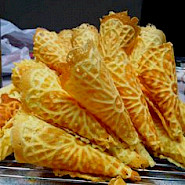 Those with a sweet tooth can satisfy their cravings with Krumkake. Translated as ‘curved or crooked cake’, Krumkake consists of paper-thin rolls of a waffle-like pancake, which are then filled with whipped cream or any other desired filling your heart desires. Tilsorte Bondepiker is as traditional as a Norwegian desert can possibly be. This desert contains mashed apples followed by a layer of whipped cream, then a layer of breadcrumbs. Simple yet delicious.
Those with a sweet tooth can satisfy their cravings with Krumkake. Translated as ‘curved or crooked cake’, Krumkake consists of paper-thin rolls of a waffle-like pancake, which are then filled with whipped cream or any other desired filling your heart desires. Tilsorte Bondepiker is as traditional as a Norwegian desert can possibly be. This desert contains mashed apples followed by a layer of whipped cream, then a layer of breadcrumbs. Simple yet delicious.
Used in many Norwegian delicacies and typically consumed during festive occasion and celebrations, Akevitt is Norway’s national drink. The name derives its roots from the Latin words aqua and vitae which translate as “water of life”. This alcoholic beverage is made from potato and is flavored with caraway, dill and other herbs and spices. Akevitt has a rich history of popularity in Norway, with its roots being traced back to the 15th century.
Fitting in...
Some things to keep in mind.....Norway is one of the most expensive countries in the world, and at the beginning you’ll feel like booking the next flight out of there. But don’t. You will get used to it and on a slightly positive note, not everything is exorbitantly expensive. For one, Norway’s social system is one of the best in the world and includes free education and healthcare. 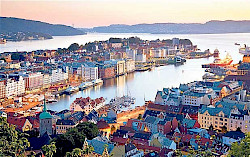
You’re not Norwegian if you don’t know how to ski. This is a nation that perfected skiing, and they sure are proud of it. I you don’t know, invest in some skis and start learning. This will also give you something to talk about with the locals.
You’ll undoubtedly start wearing one of those Norwegian sweaters. Those massive, thick, itchy, woolly, sweaters in Norwegian colors of red, white and blue and look like something your great grandfather may have worn back in the day. Plus, you’ll be one step closer to fitting in with the otherwise fashionable Norwegians.
If you know anything when assimilating into life in Norway remember that Norwegians are reserved, honest, humble and straightforward. Also, you might find that they are not outwardly social and are unlikely to greet others in shops, in the street, or even in social settings until they are more familiar with someone. To Norwegians, this is actually viewed as polite as they do not feel the need to bother anyone needlessly. It may ta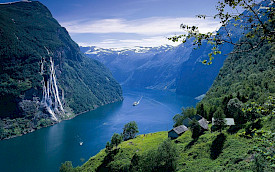 ke some adjusting to get over the feeling of being shunned, but remember, it’s not just you. This happens to everyone. However, once you have broken the ice and they’ve gotten a chance to know you, you will have friends for life.
ke some adjusting to get over the feeling of being shunned, but remember, it’s not just you. This happens to everyone. However, once you have broken the ice and they’ve gotten a chance to know you, you will have friends for life.
People are valued for their honesty, respect and goodness. Just remember that there’s cultural differences and local etiquette that you will have to grow accustomed to….embrace the differences. Once you have, you’ll get by just like a true Norwegian.